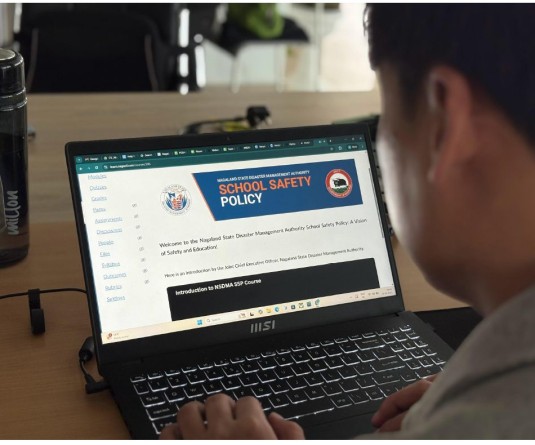
This has reference to the article which appeared in the local Dailies on 20th September, 2010, titled “Journey of Common Hope towards Future: FNR.” The article says, ‘Despite our rich documentation FNR is today putting into record that the historical and political rights of the Nagas, among many, are the following unequivocal to the Nagas.’ This article gave 5 points of declaration. Point No. 4 of this declaration says: “Nagas declared 14th August 1947 as the Naga Independence Day. In a solemn function at Mission Compound, Kohima, the Naga Flag was hoisted. The solemn function was attended by Mr. C.R. Pausey, the then Deputy Commissioner of Naga Hills District and Rev. Supplee, American Missionary.
I am compelled to point out that the above mentioned point 4 declarations is incorrect. I have enquired and made sure that nowhere in Mission Compound, Kohima on that day a “solemn function” declaring Naga Independence; where a Naga Flag was hoisted and which was claimed to have been attended by the D.C. Mr. Pausey and missionary Mr. Supplee, ever took place. The only memorable and unfortunately controversial event that took place on 14th August 1947 was when my mother, Manie Kevichusa, wife of Late A. Kevichusa, decided that Nagas got independence before India and hoisted an Angami shawl, a Lohe, as a flag in commemoration in front of their house in Mission Compound, Kohima. THERE WAS NO NAGA FLAG THEN. The shawl which belonged to my cousin Late Sabu Meruno just happened to be handy. Let me add here that this shawl happen to be around with Sabu in the house. It could have been a Sema or an Ao or a Konyak shawl. What does it matter? The only thing that mattered was it was a Naga shawl and the only available stand-in for a Naga flag that day.(After the World War II when houses got burned down and had to be rebuilt with patches-up-left-over-war-materials, shawls became rather rare). And so, Sabu’s Lohe, as a make-shift-flag was hoisted on a fat and very long bamboo pole; a variety known as ‘Vunei’ in Tenyidia. The bamboo was from uncle Zakietsolie’s bamboo groove. Mother paid eight annas (fifty paisa) for it. It was carried over to the house by one Sema boy, Azuto of Thensunyu village. Many years later, he recounted his part in the effort with elation to my brother Late Chalie Kevichusa and expressed how proud he was to have been involved in the hoisting of the first symbol of Naga Independence. The hole to set up the flag pole was dug by my brother Late Diethozor Kevichusa and Solethi, a Chakhesang boy who was with us. Thus, the shawl-turned-into-flag fluttered gaily and proudly on its tall bamboo pole high up in the air for a while, hoping to announce Naga Independence; at least to my mother and her accomplices. Incidentally, we recall Uncle Vizekho Terhuja also who was there that morning, visiting my grand-father Rev. Niser Meruno. I am positive that he was one to have greatly approves of my mother’s emotional action, although I didn’t hear him say so. But alas! A wrong impression seemed to have been given to my neighbors in the Bara-basti, ‘Khedi’ as known these days. Very soon it seemed that half of the Bara-basti converged, shouting, gesticulating and angrily pointing at the flag. (I had better not mention the reason for this uproar as it has no bearing on the matter at hand; which is the incorrect report). Things got worse with some people even threatening to burn our house down. Azuno Kruno, as we call her, mother of Late H. Zopianga, also a visitor that morning, tried to placate the angry mob and said: “Nieko neimo ro biewatuo we.” “If it is offensive to you, it will be taken down.” It was at this anxious stage that the Deputy Commissioner, Mr. Pausey came down to the scene. He asked my mother, Mrs. Kevichusa what have you done? My mother replied, “What have I done?” for what it was worth. Mr. Pausey, then, with a grunt or two of apparent amusement said to my mother, “Mrs. Kevichusa, I suggest you take down your flag for the sake of peace.” My mother, disappointed though she must have been, acquiesced to the suggestion “for the sake of peace.” Thus the short-lived Naga-flag, hoping to announce Naga Independence was that very same morning reluctantly brought down and laid to rest.
This article is written not with an intention to state what took place, but rather to state what did not take place. The above mentioned episode was anything but ‘Solemn.” It was chaotic. I wish I could have avoided narrating the unpleasant incident with our neighbors, but it became necessary to explain the D.C’s presence. Let me make it very clear here that Mr. Pausey as D.C came to the scene not to participate in a show of Naga sentiment in declaring their independence, but to restore law and order. Neither was Mr. Supplee anywhere around. (George Washington Supplee had never been a reverend, he was an educationist missionary). Who drag in our missionaries in a controversial issue that is purely ours, when we all know that they have been wrongly blamed for fomenting dissension to the Nagas and thrown out of the country for that. And can anyone really believe that a British Imperial Officer, still in office would, in his right mind, attend a ‘solemn’ function celebrating Naga Independence” or whatever especially at that particular delicate point of time?
Let us keep in mind that reckless manipulation of facts will not benefit Naga cause. It will only embarrass and can give rise to unwanted situations. My sincere hope is that the FNR, which we look up to with hope and confidence and gratitude, would take more care to be accurate, as whatever it states will become part of Naga history.
Lhusi Haralu




